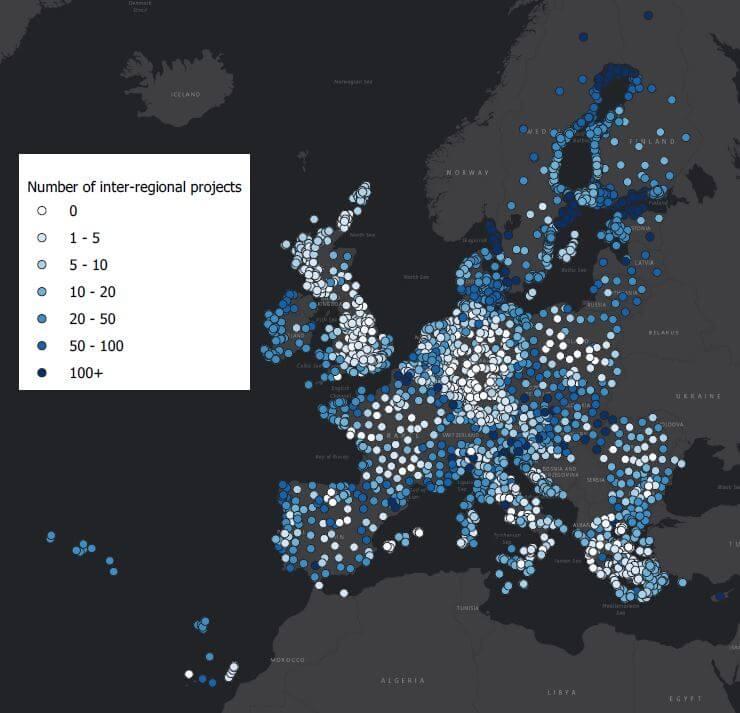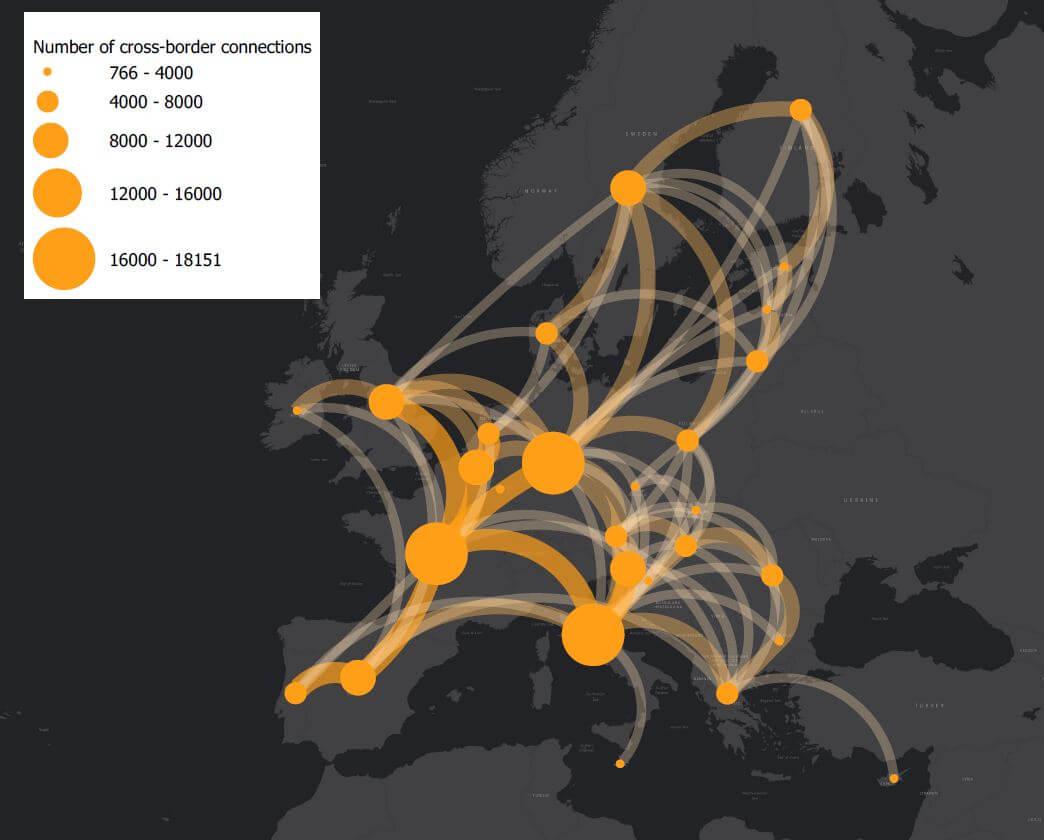Cross-border, but not national, EU interregional development projects are associated with higher growth
Our calculations reveal that places where EU regional development projects bind together participants from different countries experience higher econo

There is extensive research on European Union cohesion (or regional) policy, which aims to correct economic and social disparities between regions. We have identified more than 1,000 papers dealing with various aspects of effectiveness, convergence, inequality, governance and many other issues. Useful literature surveys include Hagen and Mohl (2009), Marzinotto (2012), Pienkowski and Berkowitz (2015) and Crescenzi and Giua (2017). These reviews show that cohesion policy has mixed results. Some studies show varied results for different countries and regions – either long-term positive impacts or short-term impacts which reverse when the inflow of funds stops. Moreover, some studies found no significant impact on regional growth, or even a negative impact.
This range of results arises from major complicating factors, related to complex local environments, the diversity of policy interventions beyond cohesion policy, varying time frames, cross-regional spill over effects, lack of appropriate data for the analysis and various econometric problems and related estimation biases resulting from, for example, reverse causality, unobserved or omitted variables, Nickell bias and measurement errors. It is therefore rather questionable whether the works that report estimates of the causal impact of cohesion policy on certain outcome indicators like economic growth really capture causality, or reflects the immense econometric problems associated with such an analysis.
Our novel methodology
Due to the problems with existing methodologies, we adopted a novel one in Darvas, Mazza and Midoes (2019a, 2019b). We identified the EU regions with the best and the worst GDP growth performance conditional on a wide range of regional factors, and then looked to see if various cohesion project characteristics differed between the best and the worst performers. Because of the difficulties in identifying the causal impact of cohesion policy, our econometric model is not designed to measure the impact of cohesion policy per se, but to sort regions according to economic performances. Good growth performance might, or might not, be related to cohesion policy and there could also be several indirect channels. For example, cohesion policy can improve infrastructure, which, in combination with state aid from the government of the country, attracts foreign direct investment, ultimately leading to faster growth, higher employment and increases in GDP per capita. Or, for example, a major natural disaster could hamper growth. Nevertheless, it is instructive to analyse the best and worst performing regions in terms of the different characteristics of cohesion policy projects to uncover interesting patterns. We also discuss certain factors that could explain the associations we found.
We identified the EU regions with the best and the worst GDP growth performance by using a conditional convergence model in which we considered numerous determinants of economic growth, by drawing on economic theory. Our strategy was to quantify the impacts of region-specific growth drivers to obtain the benchmark rate of growth, which we then compared to actual growth. We interpreted the gap between these two indicators as ‘unexplained economic growth’, which is a better measure for assessing the economic success of a region than actual growth.
We ran regressions of the growth rate of GDP per capita at PPS (purchasing power standards) between 2003 and 2015 on a number of fundamentals, and found a significant influence of the initial level of GDP PPS per capita in 2003, the capital income ratio in 2003, the percentage of employment in the tertiary sector in 2003, the growth in population between 2000 and 2003, population density in 2003, quality of governance in 2010, the share of working age people with tertiary education in 2003 and R&D personnel in percentage of total employment in 2003. It is reassuring that these variables, which have a theoretical rationale, are found to have a statistically significant influence on economic developments. We did not control for factors contemporaneous to the period of growth analysed – from 2003 to 2015 – to avoid certain econometric problems, with only one exception: regional institutional quality, since the first data point available is for 2010.
Even if we tried to consider as many growth determinants as possible, we would likely miss some factors. Such factors could be country-specific, and could be also related to the differential impact of the global and European economic crises on European countries. For example, there was no recession at all in Poland, while Greece suffered dramatically. We therefore run our regression both with and without country effects and found that our results are robust.
Our conditional convergence analysis found that among the 1,337 regions we considered, the top 10% of 133 regions comes from 21 countries, highlighting that there are rather successful regions, in terms of unexplained economic growth, in many EU countries. The unlucky bottom 10%, the 133 regions with the worst economic performance, are from 14 countries, suggesting a greater concentration. In particular, 36 of the 52 Greek regions (i.e. 69% of Greek regions) are in the bottom decile. Due to the especially disastrous growth dynamics of Greek regions, we excluded Greece from our analysis.
We compared our estimates of regions’ unexplained economic growth with the characteristics of their cohesion policy projects and found a number of interesting patterns. In this post we focus on one particular result: the role of interregional projects.
Cohesion funding and interregional projects
The European Regional Development Fund (ERDF), which is the largest among the EU cohesion (or regional) funds, aims to correct economic imbalances between regions. Only a limited share of EU cohesion policy projects connects regions. The total budget of such projects was just 4.8% of the European Regional Development Fund (ERDF) spending in the 2007-2013 Multiannual Financial Framework (MFF). Unfortunately, information about the share is not available for the current 2014-2020 MFF, nor for other cohesions funds in the previous MFF, so we are obliged to work with ERDF data.
Inter-regional projects: where are they?
Map 1 shows the number of ERDF-funded inter-regional projects in the so-called NUTS-3 regions of the EU. The distribution of interregional projects shows a concentration of projects in central Europe in particular, but there are also large numbers of such projects in Scandinavia, northern Italy, southern and northern France, Ireland and some parts of Spain. Such projects reach all corners of the EU, including its remotest islands and territories, though there are also several regions without any inter-regional project in many countries.
Map 1: The distribution of 2007-2013 ERDF-funded interregional projects in EU regions

(View map full size)
Source: Bruegel based on www.keep.eu data.
Which countries are connected the most through inter-regional projects? In order to answer this question, we gathered information on ERDF-funded inter-regional projects from the www.keep.eu dataset, allowing for an EU-wide mapping of their distribution and relative importance.
The 9,306 unique ERDF-funded inter-regional projects of the 2007-2013 MFF compose of 1,363 purely national projects and 7,943 cross-border inter-regional projects. Altogether, 1,125 of the 1,348 NUTS-3 EU regions we consider participate in at least one inter-regional project, which connect these 1,125 regions though 32,541 bilateral region-region connections. In a single project, there are often partners (such as companies or communes, for instance) of the same region, which means inter-regional projects are responsible for a total of 119,527 interregional partner-partner connections. (A project with 2 companies from a certain region and 1 company from a different one has only one bilateral region-region connection, but 2 partner inter-regional connections.)
Cross-border projects are a substantial part of the sample, with 27,124 of the 32,514 interregional connections being between regions of different countries. 25 of the then 27 EU countries have projects with all or all but one other country.
Mapping these large number of connections is tricky, especially at the regional level. We therefore add up the number cross-border projects in each EU country and show the largest number of cross-border connections at the country level, when more than more than 250 partner-partner connections exist (Map 2). Since we report the total number of connections and do not normalise this number with e.g. the size of the country, there are many more connections with big than with small countries.
It is interesting to note that most connected country pair links a relatively large country and a relatively small country, Italy and Slovenia, with a total of 4,105 partner-partner connections. The next most intense country pair is France and UK (3,104), followed by France and Italy (2,955), Belgium and Netherlands (2,890), Spain and Portugal (2,793), Belgium and France (2,791), and Germany and France and Spain andFrance, both with 2,494 connections. So, in addition to country size, geographic proximity also plays an important role in cross-border connections. Malta has more than 250 connections with Italy, while Cyprus has more than 250 connections with Greece, again highlighting the role of geographic proximity.
Map 2: Cross-border ERDF-funded project connections, 2007-2013

Note: the circles in each country illustrate the number of cross-border connection between the regions of the country in question with regions in other countries, while the lines connecting the countries represent the number of country-country connections. Only country-country combinations with more than 250 partner-partner connections are depicted. The white, narrower lines represent country-country combinations with between 250 and 800 partner connections; the medium width lines between 800 and 2000; and the widest, more orange lines, between 2000 and 4105.
Source: Bruegel based on www.keep.eu data.
Cross-border projects and economic growth
One of the clearest results emerging from our study on the effectiveness of the EU cohesion policy is the positive association between the presence of inter-regional projects and the region’s economic growth. That is, regions with a higher number of inter-regional projects, and regions with more funds allocated to such projects, tend to perform significantly better than their growth determinants would predict. The same result is not found for the budget allocated under the ERDF as a whole, pointing to different characteristics specific to inter-regional projects.
National or cross-border inter-regional projects?
By using data on several thousand projects under the European Regional Development Fund we found an unambiguous result: it is cross-border inter-regional projects which are positively, and in a statistically significant way, associated with better economic performance. The presence or the budget of purely national projects (which connect two or more regions from the same country) is never significantly associated with better economic performance, and in some specifications the direction of association is even negative.
The positive effects of the number of international projects and their allocated budget holds when considering country effects, which are of particular relevance given our sample period includes the financial crisis. Importantly, results hold both for the more developed and the less developed regions, leading us to believe that benefits from international partnerships accrue to all regions, regardless of their initial development stage.
Our conclusion from these calculations is clear: cross-border projects are worthwhile, while the benefits of purely national inter-regional projects is less obvious.
Why could cross-border inter-regional projects matter?
The evidence from our research suggests that cross-border cohesion projects can unlock beneficial partnerships. How can we explain their positive impact?
Most likely, resorting to long-distance partnerships might bring about efficiency gains for project design, procedures and implementation. In order to engage in a cross-border cooperation, partners probably consider more ambitious and far-reaching projects, since otherwise the extra administrative burden to work together with entities from other countries might not be worthwhile. Cross-border partnerships are likely established based on expertise about the specific needs of each project, and thereby could unlock synergies.
Cross-border cooperation potentially provides fruitful knowledge transfers, which could be valuable both between regions at a similar level of development and between regions with different level of development, thereby helping the less-developed regions to learn from their luckier peers.
Importantly, projects involving partners from two or more different countries could be less likely prone to corruption and waste of resources, as institutions and businesses find themselves outside their usual network of relationships and within a new, unfamiliar, environment, where playing by the rules could be the safest and most rational choice.
The participants involved in these projects include municipalities, private companies and NGOs, key stakeholders in a region. These participants are likely to incorporate their new knowledge in their day-to-day activities, as well as further explore potential international connections. This might explain the positive impact witnessed.
Yet an obvious question of causality remains: whether EU funds foster interregional projects which lead to better growth as we have just argued, or better internationally connected regions have both higher growth rates and more international projects anyway. But even in the latter case, the rationale for promoting inter-regional projects still holds, because the EU’s financial incentive might foster new international connections, which might not be formed without the EU’s financial incentive.
We therefore recommend a much wider use of cross-border inter-regional projects than their very minor share in the total budget of the 2007-2013 MFF.
In our view, inter-regional projects could provide perhaps the only rationale for the continued cohesion funding of more developed regions. These regions receive very little cohesion funding amounting to a mere 0.07 percent of the combined GDP of these regions in the 2014-2020 MFF, which could be replaced by national funding easily – this amount is even lower than any planning error in a national budget. This minor amount of funding might reach very few local beneficiaries and is unlikely to make a sizeable difference in terms of the achievement of EU goals. Yet cross-border cooperation, especially between more and less developed EU regions, could entail knowledge transfers and bring efficiency gains, thereby providing a rationale for the continued cohesion financing of more developed regions.



